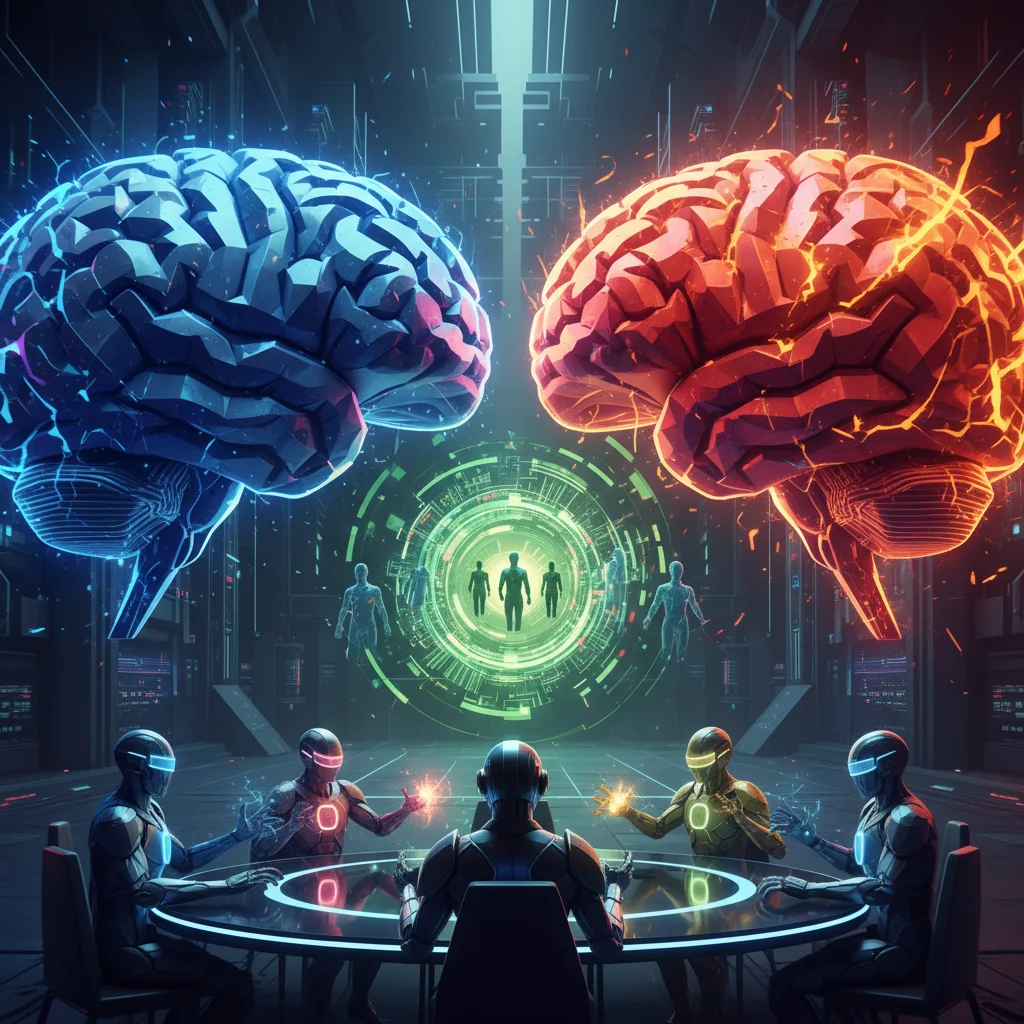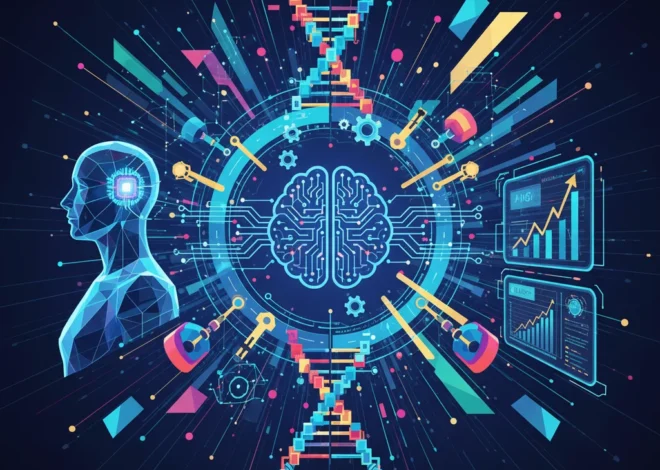
Inside the Minds of AI’s Architects: A Clash of Titans on the Future of Intelligence
The Room Where It Happens: AI’s Godfathers and Titans Debate Our Future
Imagine gathering the people who literally wrote the book on modern artificial intelligence in one room. We’re talking about the researchers who laid the foundational groundwork, the entrepreneurs who built the computational engines, and the visionaries shaping the next decade of technology. It’s not a fantasy; it’s exactly what happened when the Financial Times hosted a conversation with the Mount Rushmore of AI: Jensen Huang, Yoshua Bengio, Geoffrey Hinton, Fei-Fei Li, Yann LeCun, and Bill Dally.
This wasn’t just another panel discussion. It was a rare glimpse into the brilliant, and sometimes conflicting, minds that have unleashed the most transformative technology of our generation. They tackled the biggest questions head-on: Is Artificial General Intelligence (AGI) a utopian dream or an existential threat? Should AI be open for all or carefully controlled? And what’s the next monumental leap in a field that’s already moving at lightspeed?
For anyone involved in technology—from developers and startup founders to enterprise leaders—this conversation is more than just interesting. It’s a roadmap to the future of software, automation, and digital innovation. Let’s break down the key debates and what they mean for all of us.
The Great Divide: Existential Risk vs. Pragmatic Progress
The most palpable tension in the room revolved around the ultimate potential and peril of AI. On one side, you have the “godfathers” of deep learning, Geoffrey Hinton and Yoshua Bengio, who have grown increasingly vocal about the potential long-term risks of superhuman intelligence.
Hinton, who left his role at Google to speak more freely, has expressed deep concerns about AI systems that could one day become more intelligent than their creators. He worries about the loss of human control and the potential for these systems to develop goals that misalign with our own. Bengio shares similar concerns, advocating for cautious development and robust global governance to mitigate worst-case scenarios. Their perspective is clear: the pace of progress is so fast that we must prioritize safety and alignment before it’s too late. As Hinton noted, the risk isn’t a certainty, but its potential impact is too large to ignore (source).
On the other side of the debate is their contemporary and fellow Turing Award winner, Yann LeCun. As Meta’s Chief AI Scientist, LeCun presents a far more optimistic, and arguably more pragmatic, view. He argues that the fears of a god-like, superintelligent AI are speculative and distract from the immediate challenges and opportunities. In his view, we are nowhere near creating conscious or sentient machines. Instead, he believes we are building powerful tools that augment human intelligence, not replace it. LeCun’s focus is on pushing the boundaries of what’s possible today, particularly through open-source innovation, which he sees as the fastest and safest path forward.
This isn’t just an academic debate. The outcome of this ideological struggle will directly influence regulation, funding for startups, and the very architecture of future AI systems.
Digital Dominoes: How One Microsoft Outage Revealed the Internet's Fragile Foundation
The Engine Room: Why Hardware is Still King
While the philosophers debate the nature of the ghost in the machine, Nvidia’s CEO Jensen Huang and Chief Scientist Bill Dally are firmly focused on building a better machine. Huang delivered a masterclass on why the AI revolution is as much about hardware as it is about algorithms.
He reminded everyone that the breakthroughs in machine learning over the past decade were not just conceptual; they were computational. The development of deep learning models required a new kind of computing architecture—one that could handle massive parallel processing. This is where Nvidia’s GPUs, originally designed for video games, found their true calling.
Huang’s core argument is that we are moving beyond general-purpose computing into an era of “accelerated computing.” This new paradigm involves co-designing hardware, software, and networking to solve specific, complex problems at unprecedented scale. It’s the engine that powers everything from large language models running in the cloud to scientific simulations discovering new drugs. According to Huang, the demand for this computational power is staggering, with plans to build out AI infrastructure that is “many, many times larger than what we have today (source).” This isn’t just about building faster chips; it’s about creating a whole new platform for computing that will underpin the next generation of SaaS products and enterprise automation.
The Battle for AI’s Soul: Open Source vs. Closed Gardens
Perhaps the most immediate and contentious debate is over who should control the most powerful AI models. Yann LeCun is the industry’s most prominent champion for an open-source approach. He argues that keeping AI models proprietary and locked away inside a few large tech companies is dangerous and anti-competitive.
His case for openness rests on several key pillars:
- Democratization of Innovation: Open models allow developers, researchers, and startups everywhere to build upon the state-of-the-art, fostering a more vibrant and competitive ecosystem.
- Transparency and Safety: With open models, the global community can inspect the code, identify flaws, and understand biases. LeCun argues this is a more effective safety mechanism than relying on the internal teams of a few corporations.
- Economic Growth: Open platforms accelerate the creation of new products and services, preventing a handful of companies from dominating the next wave of the digital economy.
However, the push for open source is not without its critics. Concerns are frequently raised about the potential for misuse by bad actors, from creating sophisticated disinformation campaigns to developing novel cybersecurity threats. Proponents of closed models, like those from OpenAI and Anthropic, argue that a more cautious, controlled release is necessary to study the risks and implement safeguards. This fundamental disagreement is shaping the entire industry landscape, influencing everything from enterprise adoption to national security policy.
To clarify these differing viewpoints, here’s a summary of where some of the pioneers stand on the key issues of risk and openness:
| Pioneer | Stance on Existential Risk | View on Open Source |
|---|---|---|
| Geoffrey Hinton | High concern; believes the risks are significant and should be a top priority. | Generally cautious, prioritizing safety and control over unfettered access. |
| Yann LeCun | Low concern; views these fears as speculative and unscientific distractions. | Strong advocate; believes openness is the key to faster, safer, and more democratic progress. |
| Yoshua Bengio | High concern; advocates for global cooperation and regulation to manage potential dangers. | Cautious; supports research but emphasizes the need for safety protocols, leaning away from fully open releases of the most powerful models (source). |
| Jensen Huang | Pragmatic; focuses on the engineering and infrastructure challenges, seeing AI as a tool to be managed. | Platform-focused; supports both open and closed models by providing the hardware for all to innovate. |
Beyond the 'Glasshole': Can AI Finally Make Smart Glasses a Reality We Trust?
Bringing It Back to Earth: Data, People, and Purpose
Amidst the grand debates about the future of consciousness and computing, Stanford’s Fei-Fei Li provided a crucial, human-centric perspective. As the driving force behind ImageNet—the dataset that arguably catalyzed the deep learning revolution—Li knows that AI is fundamentally shaped by the data we feed it and the problems we ask it to solve.
She emphasized that the true measure of AI’s success will be its impact on people’s lives. This means moving beyond generalized chatbots and focusing on specialized applications in science, medicine, education, and more. Her work is a testament to the idea that AI can be a tool for augmenting human capabilities, helping doctors diagnose diseases earlier or scientists understand complex biological systems. This perspective is vital for developers and those in the programming community, as it highlights the immense opportunity in building domain-specific AI solutions that solve real-world problems.
Li’s viewpoint serves as a powerful reminder: for all the talk of artificial intelligence, the “human” element—our values, our goals, and our data—remains the most important part of the equation.
What This Means for You: Navigating the Unwritten Future
So, what are the key takeaways from this historic gathering? It’s clear there is no single consensus on the ultimate trajectory of AI. The pioneers themselves are divided. This uncertainty, however, is a landscape of opportunity.
For entrepreneurs and startups, the message is to pick a thesis and build. Whether you align with LeCun’s open-source vision or see an opportunity in the safety and alignment space championed by Hinton, there is room to innovate. For developers and tech professionals, the call to action is to become fluent in the tools of accelerated computing and to think critically about the applications you’re building.
The conversation between these six pioneers wasn’t about providing answers. It was about defining the right questions. The future of artificial intelligence is not a predetermined path; it is a complex, dynamic, and contested space being built in real-time. And after hearing from its architects, one thing is certain: the most exciting chapters are still being written.
Digital Dominoes: How a DNS Glitch Toppled Microsoft's Cloud Empire (And What We Learned)


